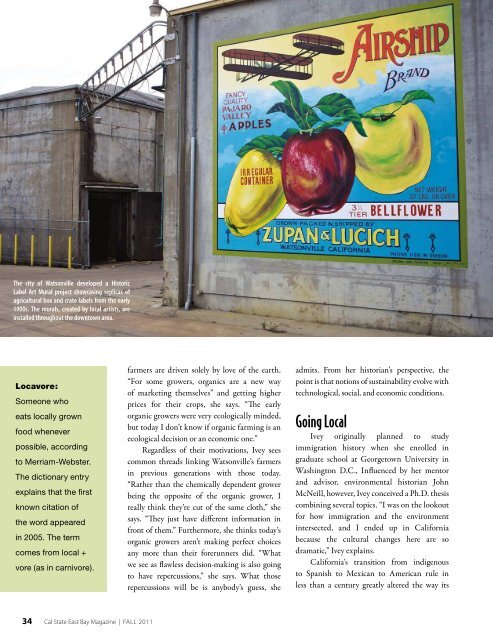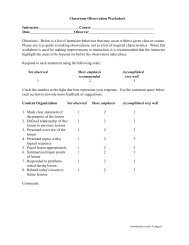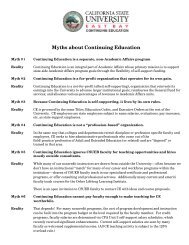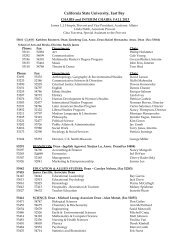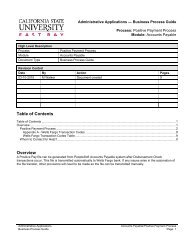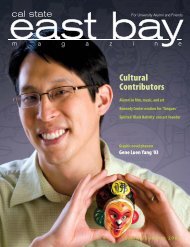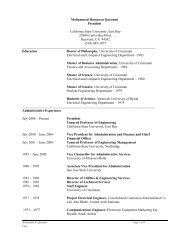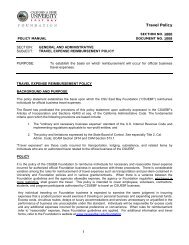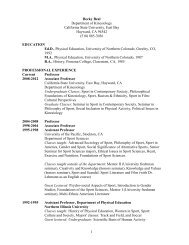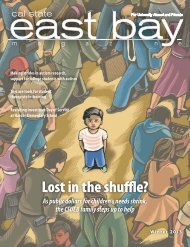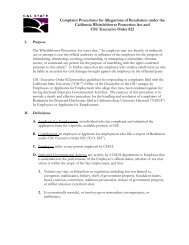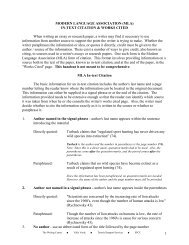Fall 2011 - California State University, East Bay
Fall 2011 - California State University, East Bay
Fall 2011 - California State University, East Bay
Create successful ePaper yourself
Turn your PDF publications into a flip-book with our unique Google optimized e-Paper software.
The city of Watsonville developed a Historic<br />
Label Art Mural project showcasing replicas of<br />
agricultural box and crate labels from the early<br />
1900s. The murals, created by local artists, are<br />
installed throughout the downtown area.<br />
Locavore:<br />
Someone who<br />
eats locally grown<br />
food whenever<br />
possible, according<br />
to Merriam-Webster.<br />
The dictionary entry<br />
explains that the first<br />
known citation of<br />
the word appeared<br />
in 2005. The term<br />
comes from local +<br />
vore (as in carnivore).<br />
farmers are driven solely by love of the earth.<br />
“For some growers, organics are a new way<br />
of marketing themselves” and getting higher<br />
prices for their crops, she says. “The early<br />
organic growers were very ecologically minded,<br />
but today I don’t know if organic farming is an<br />
ecological decision or an economic one.”<br />
Regardless of their motivations, Ivey sees<br />
common threads linking Watsonville’s farmers<br />
in previous generations with those today.<br />
“Rather than the chemically dependent grower<br />
being the opposite of the organic grower, I<br />
really think they’re cut of the same cloth,” she<br />
says. “They just have different information in<br />
front of them.” Furthermore, she thinks today’s<br />
organic growers aren’t making perfect choices<br />
any more than their forerunners did. “What<br />
we see as flawless decision-making is also going<br />
to have repercussions,” she says. What those<br />
repercussions will be is anybody’s guess, she<br />
admits. From her historian’s perspective, the<br />
point is that notions of sustainability evolve with<br />
technological, social, and economic conditions.<br />
Going Local<br />
Ivey originally planned to study<br />
immigration history when she enrolled in<br />
graduate school at Georgetown <strong>University</strong> in<br />
Washington D.C., Influenced by her mentor<br />
and advisor, environmental historian John<br />
McNeill, however, Ivey conceived a Ph.D. thesis<br />
combining several topics. “I was on the lookout<br />
for how immigration and the environment<br />
intersected, and I ended up in <strong>California</strong><br />
because the cultural changes here are so<br />
dramatic,” Ivey explains.<br />
<strong>California</strong>’s transition from indigenous<br />
to Spanish to Mexican to American rule in<br />
less than a century greatly altered the way its<br />
inhabitants produced food and related to the land. To study the<br />
change from subsistence family farming to a business model,<br />
Ivey traveled to Monterey, the 19 th -century capital of Mexicancontrolled<br />
<strong>California</strong>. Her attention eventually settled on the<br />
early decades of the 20 th century, when the industrial revolution<br />
rippled through agriculture: Farmers stopped raising a mix of<br />
crops (with the intention of feeding their families and selling or<br />
trading the excess) and began raising single crops, often with the<br />
help of chemical sprays and automation.<br />
Searching for primary sources to understand this period,<br />
Ivey hit paydirt at the Pajaro Valley Historical Association in<br />
Watsonville: dozens of oral histories, collected in the 1970s and<br />
1980s, that captured second-generation farm owners talking<br />
about their lives and those of their parents. Ivey expected to find<br />
stories that fit the image of <strong>California</strong> agriculture put forth by<br />
crusading journalist Carey McWilliams in his 1939 bestseller<br />
Factories in the Field. McWilliams had presented <strong>California</strong><br />
farm owners as wealthy and white, abusive of their laborers<br />
(often people of color), detached from the land, greedy, and<br />
shortsighted.<br />
“But when I looked locally at Watsonville, I realized its story<br />
is much more complex,” Ivey says. For example, she found many<br />
ethnic groups — including Japanese, Portuguese, Italians, and<br />
Slavonians (from present-day Croatia) — owning neighboring<br />
farms, running agriculture-related businesses, sharing<br />
information, and generally supporting one another. “These<br />
were the good guys,” Ivey concluded. “They weren’t greedy or<br />
aggressive. They were just trying to stay in business. And a lot<br />
of organic growers today are the same guys, trying to keep their<br />
families fed.”<br />
That’s not to say Watsonville in the early 20 th century was a<br />
multiethnic utopia. There were clashes, sometimes violent. But<br />
the overarching point, Ivey says, is that the story of immigration<br />
and agriculture in Watsonville was more nuanced — and, in<br />
the end, more interesting — than any generalized image of<br />
<strong>California</strong> agriculture. The research had converted Ivey into a<br />
sort of historical locavore. “I had never thought much about local<br />
history,” she admits, “but I realized that when you look at local<br />
stories, that’s when you see the complexity.”<br />
Acknowledging that complexity makes Watsonville’s growers,<br />
and the choices they made, more understandable and relevant to<br />
Ivey and her students. “I’m an advocate for understanding how<br />
decisions were made in the past, rather than just saying people were<br />
greedy or racist or bigoted,” Ivey explains. “I don’t think you study<br />
history because you can learn lessons from the past. You can learn<br />
lessons about your present by understanding how decisions were<br />
made in the past.” n<br />
WEB EXTRA: Learn how students are getting experience in the field<br />
conducting public history at www20.csueastbay.edu/news/magazine.<br />
Cultivating<br />
Historical<br />
Perspective<br />
By Fred Sandsmark ’83<br />
The question of “how we got here” underlies<br />
Linda Ivey’s research into local agriculture<br />
and the food system. It also is the basis of<br />
her teaching at Cal <strong>State</strong> <strong>East</strong> <strong>Bay</strong>.<br />
That’s why Ivey often begins her classes<br />
with one of today’s big questions and works<br />
backward. “In both my environmental<br />
history class and my immigration history<br />
class, we start with a contemporary topic,”<br />
such as climate change or migrant farm<br />
workers’ conditions, she explains. She then<br />
helps students connect current affairs to<br />
the historical events and actions they’re<br />
studying. It’s a powerful teaching technique,<br />
she observes, especially for the nonhistory<br />
majors fulfilling general education<br />
requirements that represent the majority of<br />
students in her classes.<br />
“Whether it’s the debate over the<br />
(Sacramento-San Joaquin) delta, or<br />
wildfires in Southern <strong>California</strong>, or food<br />
system issues, the question is this: How did<br />
we get to the point where this is an issue?”<br />
Ivey explains. “It’s about understanding the<br />
evolution of thought about the environment,<br />
which went from something that seemed<br />
plentiful and endless to something to be<br />
controlled. Same with immigration: We<br />
start with the contemporary immigration<br />
debate and explore when and how people<br />
became ‘illegal.’ Everything we learn is about<br />
understanding the present debate.”<br />
faculty<br />
34 Cal <strong>State</strong> <strong>East</strong> <strong>Bay</strong> Magazine | FALL <strong>2011</strong> Cal <strong>State</strong> <strong>East</strong> <strong>Bay</strong> Magazine | FALL <strong>2011</strong> 35


